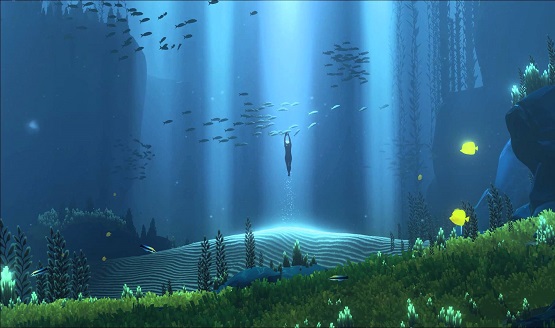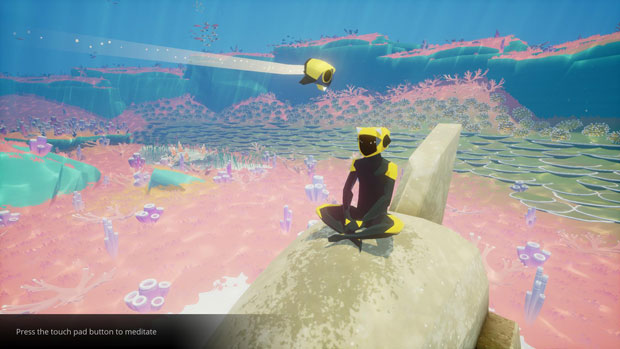Abzu derives form the ancient words, Ab, for “ocean,” and Zu, which means “to know.” Developers over at Giant Squid intended the interpretation of the title to read as, “ocean of wisdom.” On surface level, it seems as if Abzu is a game similar in style to Journey, but underwater instead of in the desert. While that is not far from the truth, I feel that the creator Matt Nava took the great model that is Journey, and created a very refreshing and meditative experience in Abzu.
 What is immediately apparent in Abzu is the art style and choice of color. This may easily be one of the most beautiful games on the market right now. While it does not have the production value of an Uncharted 4 or The Order:1886; Abzu itself has an art style that puts vibrant colors on blast as you watch seaweed dance to and fro in the ocean currents and the cornucopia of different colored fish swimming in schools of its brethren as they swirl around you in ways that are graphically appealing. So, sure, it may not have the best graphics on the market, but it has an art style that will leave a bigger impact on you than either of the games listed above.
What is immediately apparent in Abzu is the art style and choice of color. This may easily be one of the most beautiful games on the market right now. While it does not have the production value of an Uncharted 4 or The Order:1886; Abzu itself has an art style that puts vibrant colors on blast as you watch seaweed dance to and fro in the ocean currents and the cornucopia of different colored fish swimming in schools of its brethren as they swirl around you in ways that are graphically appealing. So, sure, it may not have the best graphics on the market, but it has an art style that will leave a bigger impact on you than either of the games listed above.
While the visuals are breathtaking, the real thing that will stick with you well past the game’s playtime is the musical score. Just like Journey, the music is composed by Austin Wintory. Wintory’s work on Journey won a Grammy back at the game’s launch, making it the first game to ever get such an accolade. While Journey’s musical score was beyond memorable, Abzu one ups it in every way imaginable. The score swells up in all the right moments, while taking more somber approaches at other times. More than once I found myself setting the controller down simply to take in the amazing score. Eye bleeding visuals elevate the music in ways that are appealing to all of the senses. Nearly one month later after launch and it is still high on my list of go-to tunes when I am at work.
The controls themselves are simple and practical. You will find yourself lackadaisically exploring each area as you discover new fish and take in the beautiful scenery. Rocks are placed so that your character can meditate which gives you a nice view of the area you occupy. The player can hitch a ride on large animals, locate quick moving sea currents, as well as breach out of the water like a whale. There are small narrative moments where the player discovers old tech that can be re-programmed with the intent to follow you from place to place. Additionally, the game adds ancient murals and hieroglyphics that tell a story – if you can put the pieces together.
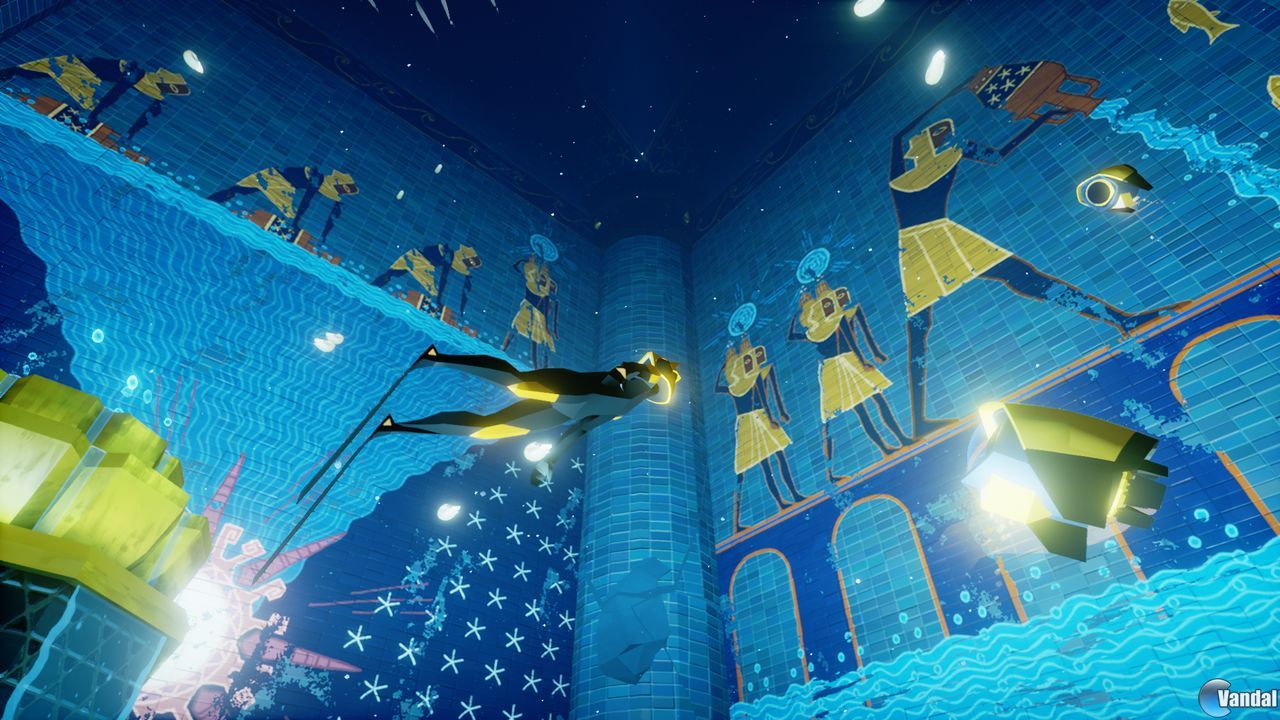
Hieroglyphics are all around this world and if you are visually keen, you can piece together the environmental story.
Much like Journey, the story itself is in the journey you are taking. Piecing together out of context murals and relationships you build with other sea life is just the tip of the iceberg. Come the game’s end, you will have many questions and be left with a plethora of thoughts as to what exactly you just experienced. While it doesn’t have the emotional resonance as Journey, the ending did have a smile breach across my face. It was a grin so wide that it is hard to even claim that the game did not have some sort of impact on me.
Abzu is a beautiful game, with a wonderful score, and is filled with smile inducing moments. If you enjoy these art based, short experiences, I highly recommend you give this one a try. While it may feel like a beat for beat retread of Matt Nava’s previous work, the game speaks for itself as a brand new experience. Ideas are taken from Journey and utilized in brilliant way to create a new experience that still feels familiar in all the right ways. Do yourself a favor and get lost in the world of Abzu.
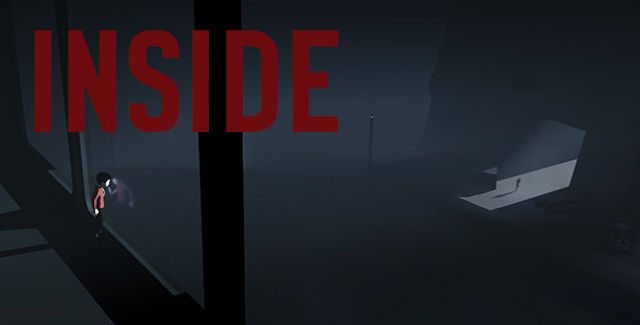 Smaller experiences, or “indies” as they are called, are the heart of the video game industry right now. Over the years we have been blessed by the gamer gods with experiences such as Journey, Brother: A Tale of Two Sons, Gone Home, Ori and the Blind Forest, and more recently Firewatch. Now we are bestowed Inside upon us. Inside is an Xbox One console exclusive (also available on Steam), and if you own an Xbox One, you are required to play it…it’s just that simple.
Smaller experiences, or “indies” as they are called, are the heart of the video game industry right now. Over the years we have been blessed by the gamer gods with experiences such as Journey, Brother: A Tale of Two Sons, Gone Home, Ori and the Blind Forest, and more recently Firewatch. Now we are bestowed Inside upon us. Inside is an Xbox One console exclusive (also available on Steam), and if you own an Xbox One, you are required to play it…it’s just that simple.
Inside comes from the studio, Playdead, who brought us all Limbo back in 2010. Limbo was known for its ambient storytelling, interesting art style, and clever puzzles. Inside is the obvious step forward for this studio as they take everything they learned from creating Limbo, and implement those lessons and new ideas into what is easily one of the greatest gaming experiences I have played this year…nay…this generation.
Inside starts off very much like Limbo. You are a young boy, in a dark forest, running to the right of the screen as you complete simple but smart environmental puzzles. The ambient story telling that was in Limbo returns here and it works even better this time around. Right off the back I get the conflict, and I understand the story. My goal is to survive in this dystopian world by any means necessary. Strange men in masks chase the young boy, sending dogs after him, and hunt him down using vehicles and flashlights as a sense of tension is created that not only has me caring about my survival, but has me clutching my controller as I make close calls, and quick escapes. “Go, go, go go, go!” seems to be my inner mantra as I run daringly across the levels and make leaps of faith into the unknown, in hopes for a brief respite. The sense of atmosphere is so cleverly pieced together, as the hauntingly beautiful aesthetic works for the bleak story they are trying to convey. Part of that tension building is accompanied by the outstanding soundtrack that again is more ambient than it is present. The game is all about having the story pieces on display, but making you put them together by being observant. The environment tells a better story than most games with spoken word, which this game lacks completely. The implementation of color is also noteworthy. What starts of as muted blacks and whites we are then slowly introduced to more colors as the pallet expands itself out but never to the point of being colorful. The game retains its tones through its implementation of these muted colors and this works majorly to its themes, and tone.
 The game controls are simple and smooth. Directional joysticks control you character, and one of the face buttons act as your jump while another acts as your “interaction” or “grab.” At no point did I ever find myself fighting against the control layout or the mechanics themselves. The puzzles are frequent but never overbearing. I am not a puzzle fan at all, and not once did I ever find myself checking my watch for how much time I spent on a section or even worse, getting bored. I found myself using the word, “smart,” over and over again. Smart is the way I felt when I completed a puzzle, and it was what I kept saying out loud when seeing the mechanics and layout of said puzzles. The design of this game is just brilliant, in every sense of the word. The Inside experience had a stranglehold on me, and has me rethinking how I feel about the puzzle/platforming genre in general.
The game controls are simple and smooth. Directional joysticks control you character, and one of the face buttons act as your jump while another acts as your “interaction” or “grab.” At no point did I ever find myself fighting against the control layout or the mechanics themselves. The puzzles are frequent but never overbearing. I am not a puzzle fan at all, and not once did I ever find myself checking my watch for how much time I spent on a section or even worse, getting bored. I found myself using the word, “smart,” over and over again. Smart is the way I felt when I completed a puzzle, and it was what I kept saying out loud when seeing the mechanics and layout of said puzzles. The design of this game is just brilliant, in every sense of the word. The Inside experience had a stranglehold on me, and has me rethinking how I feel about the puzzle/platforming genre in general.
It took me about two hours to complete Inside, and the average seems to be in that range, or around 3 hours for those who take in the sights a bit more or get caught longer on a few of the less hand holding puzzles. It is an experience I highly suggest you play in one sitting, so you get the full immersion of what the story has to offer.
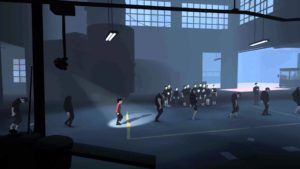 While this game is very much about the journey, it is equal parts about the destination. Thankfully, Inside’s ending delivers in every way. No worries, I refuse to spoil it here because it needs to be experienced, heck I doubt I would do it any justice. What I will say, is that the ending is thought provoking, head scratching, WTF inducing, and very much so open to interpretation. I suspect people will be talking about the end of Inside much like gamers talked about the ending of Journey for years after its release. Even right now, there are thousands of discussions happening between players of Inside who are bouncing theories, ideas, and their own interpretations off one another. If a game can spark so much conversation, then to me that makes it more than the sum of its parts. All the praise and accolades this game has gotten from players and critics alike are warranted. If you own an Xbox One, or are part of that ever so loving PC Master Race, you need to do yourself a favor and drop everything you are doing and purchase Inside. You want to be part of this conversation because this will be a game that inspires many, inside and outside of the industry.
While this game is very much about the journey, it is equal parts about the destination. Thankfully, Inside’s ending delivers in every way. No worries, I refuse to spoil it here because it needs to be experienced, heck I doubt I would do it any justice. What I will say, is that the ending is thought provoking, head scratching, WTF inducing, and very much so open to interpretation. I suspect people will be talking about the end of Inside much like gamers talked about the ending of Journey for years after its release. Even right now, there are thousands of discussions happening between players of Inside who are bouncing theories, ideas, and their own interpretations off one another. If a game can spark so much conversation, then to me that makes it more than the sum of its parts. All the praise and accolades this game has gotten from players and critics alike are warranted. If you own an Xbox One, or are part of that ever so loving PC Master Race, you need to do yourself a favor and drop everything you are doing and purchase Inside. You want to be part of this conversation because this will be a game that inspires many, inside and outside of the industry.


